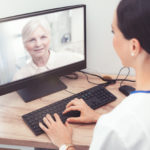By Robert Burke

April 8, 2020
Telehealth in its many forms was already a growing market before the COVID-19 pandemic erupted, but now the demand is much higher.
Surveys done in March by Jobson Optical Research show a rush of interest in telehealth technologies, as eyecare professionals (ECPs) face a shrinking pool of patients and increasingly see telehealth as key to their financial survival.
Here is what the telehealth companies are experiencing during the COVID-19 rush to “see” patients virtually, along with information about the services they offer.
COVID-19 Telehealth Rush
“Our business has literally doubled and quadrupled in the last two and a half weeks,” says Beth Samenuk, vice-president of sales for EyecareLive, which offers a digital platform that allows ECPs and patients to access each other online. She says interest picked up beginning with the SECO meeting in early March and hasn’t slowed down. “We’re working 18 hour days.”
Other Pieces to Explore
The Jobson surveys also show the damage the pandemic is doing to the optometry sector. By the end of March more than 88 percent of respondents said they have or are considering reducing their practice or store hours. More than 51 percent reported a voluntary temporary closing, driven largely by a lack of patients and customers.
Brick-and-Mortar Dependent Telehealth Systems
“We have never had more interest and more activity than we have had in the last several weeks,” says Chuck Scott, CEO of 20/20 Now, a company that provides digital eye exams but requires patients to come to a physical location for testing. “Before the COVID-19 environment came upon us there were many skeptics and many doubters. The new reality has woken up a lot of people to the fact that they need telehealth. Not only for their practice but for their patients.”
Another system dependent on brick and mortar locations is MyVisionPod systems, which use a single location with the technology to gather the diagnostic data an ECP would need to treat a patient, yet most of the convenience is for the ECP and not to the patient. Same with optomap devices. Patients have to go to a ECP provider locations, but if they do and if the ECP can guarantee some COVID-19 protections, the technology can work.
Help Possibly Coming for ODs to Buy Necessary Equipment
Scott says his company is working now on a new telehealth format that will let ECPs consult with the patient at their home. Plus, it is teaming up with a diagnostic technology company and a lending institution to offer a way for practices to buy the necessary equipment. The company will have more details soon, but this new strategy is a radical makeover. “Obviously the impact on the bricks and mortar has made us think hard about our business model,” Scott says.
There are a range of formats and technologies on the market now and more are on the way. Samenuk says EyecareLive is “uniquely built for optometry. The beauty of our platform is that it is accessible by both the doctor and patient.”
Direct-to-Consumer Options
Some companies offer devices sold directly to consumers to let them gather data about their eye health and deliver it to their ECP.
A company called Icare Home sells a variety of tonometers directly to patients that lets them measure intraocular pressure and deliver those results to their ECP to help them monitor their glaucoma. EyeQue sells products directly to consumers that will let them measure refractions, using a device and a smartphone.
EyeQue sells products that can can attach to a smartphone, such as its $69 VisionCheck device that attaches to a smartphone to test patients’ eyes from home, and use the test results to order their eyeglasses. This device isn’t in the hands of an optometrist. It is for patients who need a vision correction. After three checks using the device, a user is provided the data they can use to order new glasses online.
Doctors Are Finally As Enthusiastic As Patients About Telehealth
Howard Fried, OD, president of DigitalOptometrics, is marketing a product that connects patients and ODs via digital platforms. “We were busy beforehand, but now it’s been much larger volume coming through. And it’s not just customers who have requested to look at implementation but also we’re getting a ton of doctors who have asked now to be a part of this,” he says.
“Doctors are asking, ‘How do we get back to business in the short term and what’s our long-term solution?’,” Fried says.
We’re a long way away from a COVID-19 vaccine, so we have to find a way to see patients, but do so in a way that’s safe for them as well as for the doctors.”
Robert Burke is managing editor of Review of Myopia Management. To contact him: rburke@jobson.com

























